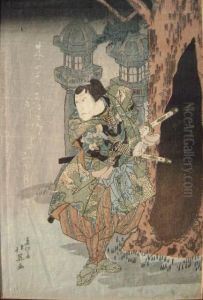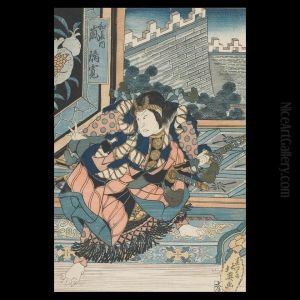Shunbaisai Hokuei Paintings
Shunbaisai Hokuei was a designer of ukiyo-e style Japanese woodblock prints, active during the late Edo period. He was born around 1780, although the exact date is not known. Hokuei was best known for his yakusha-e, or actor portraits, which depicted the kabuki theater actors of his time. He was one of the prominent Osaka-based artists, contributing to the Osaka print movement, which was known for its distinctive style separate from the Edo (present-day Tokyo) printmaking culture.
Hokuei's career as a printmaker began in the 1820s, and he quickly established himself as a talented artist in the Osaka school, which was then led by figures such as Shunkosai Hokushu. Working under the go (artist name) Shunbaisai Hokuei, he produced prints that were characterized by their vivid colors, dynamic composition, and the expressive portrayal of kabuki actors. Hokuei's prints often captured the lively and dramatic moments of kabuki performances, making them popular among theatergoers and print collectors.
His work is also noted for the use of 'deluxe' techniques, such as embossing and metallic pigments, which added a luxurious quality to his prints. These techniques, along with the use of rich colors and attention to detail, contributed to the unique and sought-after aesthetic of Osaka prints. Hokuei's focus on actor prints contributed to the flourishing of celebrity culture in Japan, where kabuki actors were the stars of the day.
Hokuei's contributions to the world of Japanese art continued until his death in 1837. Despite his relatively short career, he left behind a body of work that is still admired for its artistic quality and cultural significance. Today, his prints are considered important examples of Osaka ukiyo-e and are studied by scholars and enjoyed by collectors around the world. They not only provide insights into the popular culture of the Edo period but also exemplify the craftsmanship and beauty of Japanese printmaking.

